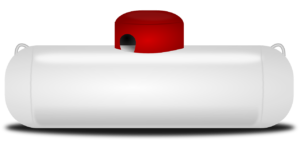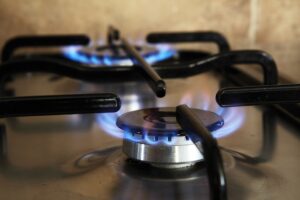
Aboveground propane tank
Scientifically speaking, propane is a hydrocarbon (C3H8). The gas is also referred to as liquefied petroleum gas, LP-gas, and LPG.
In layman’s terms, propane is one of the most widely-used fuels in America and can be utilized for a host of reasons, including:
Propane is plentiful, environmentally-friendly, and affordable, making it one of the most desirable options homeowners have for heating and cooling.
A little known fact is that propane was not purposefully created. Rather, its energy density was discovered on accident by chemist Dr. Walter O. Snelling.
When Snelling was on his way home from a fueling station, he couldn’t help but notice the cork on his gas can kept popping off. After learning gasoline had volatiles in it, he discovered that if he could convert the fractionate — now known as propane — into an isolated liquid, he’d have an incredible new fuel source. The propane we have today is a by-product of natural gas processing and crude oil refining.
During natural gas processing, the liquid components recovered are:
Crude oil refining produces propane, butane, and other gases.
By extracting propane from each process, the result is a cleaner, more dense energy source.
Between 80-90% of propane consumed in the United States is produced domestically. (The other 10-20% of propane is mostly from Canada.) That means if you power your home with propane, each time you refill your tank you’re supporting the U.S. economy.
Some oil companies, like those located in North Dakota, Montana, Manitoba, and Saskatchewan, have natural gas processing plants located in their oil fields and separate the LPGs on-site.
If the hub is large enough, they may store their own propane, too. LPGs are typically stored in large underground salt caverns that were hollowed out in the 1940s, but some areas without suitable geology will use aboveground tanks.
If a hub is not large enough to store their own propane, the transportation process begins. Propane is usually transferred through rail, truck, ship, or pipelines.
According to the Energy Information Administration (EIA), the distribution channels of propane are represented in the following image:

Propane distribution channels
After storage, propane continues its journey through a pipeline to a pipeline terminal. Watch this animated video to see where propane pipelines run through the U.S.
Once at the pipeline terminal, propane will travel to retail plants across the nation. From there, individual companies either sell or transport propane for consumer homes.
Regardless of where the propane is found, getting it your home is simple. In fact, you can access a comprehensive list of all propane locations in the U.S. and Canada from the U.S. Department of Energy.
And, if you live in Connecticut, you can find your propane at Santa Energy.
Santa Energy is known for its dependable delivery, and it’s reliable customer service, meaning you’ll get your fuel or service promptly, no matter how bad the weather conditions are. You can also set up an automatic propane delivery, which means we’ll track the levels of your fuel, and send out a new delivery before your supply runs out.
Homeowners use propane for a vast number of tasks: home heating, water heating, clothes drying, fireplaces, cooking and back-up power. To ensure there is enough propane for all of your home energy needs, it’s important to check your propane tank fuel gauge on a regular basis.
Not only is it an easy way to make sure you always have enough fuel, but it’s critical to your safety.
If a propane tank runs out of gas completely, it may introduce air into the system, which can cause damage to the tank, or worse, may cause your pilot lights to go out.
If not handled properly, this situation can be dangerous. As a result, federal code requires you have a professional inspect your entire propane system before you can turn the gas back on.
To avoid these issues, learn how to read your propane tank fuel gauge so your family — and home — are safe.
One of the most important things to understand about your propane tank is that the fuel gauge shows you the fuel level as a percentage of the capacity of your tank, not the total amount of gallons in the tank.
While not all propane tanks have the same gauges, their purpose remains the same: to show you how much propane is left in the tank. Most gauges are “float gauges,” (like the fuel gauge in a vehicle), which reads the level of liquid propane in the tank via a floating arm. As the level drops, so does the float gauge.

Knowing how to read the gauge will help you know when it’s time to request a refill.
Below are a couple examples of propane gauges plus some tips on how to read them.

A propane gas fuel gauge showing a tank that is 75% full. (Photo/ Kaufmann Gas)
As a precaution, refill your gas once your fuel gauge reads 20% (or below).

A propane tank that has run far below the recommended 20% level — this tank is less than 10% full. ( Photo/ Ressler Propane)
If you have a propane tank for home energy usage, then you’ve probably noticed that after a propane delivery, the tank gauge reads 80%.
Don’t worry, you’re not being scammed and there is nothing wrong with your tank or the gauge. Although you use propane in gas form, propane is stored as a liquid in your tank to allow it space to expand and contract as the ambient temperature rises and falls. The maximum fill percentage is always going to be 80%.
You can perform some simple math to determine how much gas is in your propane tank. Just multiply the tank’s capacity by the reading on the tank gauge.
For example, if your 500-gallon tank is showing a gauge reading of 60%, that means you have 300 gallons of gas remaining in your tank (500 x 0.6).
If you want to skip the math, here’s a handy chart that will tell you how much gas is left in your propane tank based on your tank size and your gauge reading:
| Gauge Reads | 120-Gallon Tank | 250-Gallon Tank | 500-Gallon Tank | 1,000-Gallon Tank |
| 80% | 96 gallons | 200 gallons | 400 gallons | 800 gallons |
| 70% | 84 gallons | 175 gallons | 350 gallons | 700 gallons |
| 60% | 72 gallons | 150 gallons | 300 gallons | 600 gallons |
| 50% | 60 gallons | 125 gallons | 250 gallons | 500 gallons |
| 40% | 48 gallons | 100 gallons | 200 gallons | 400 gallons |
| 30% | 36 gallons | 75 gallons | 150 gallons | 300 gallons |
| 20% | 24 gallons | 50 gallons | 100 gallons | 200 gallons |
| 10% | 12 gallons | 25 gallons | 50 gallons | 100 gallons |
Now that you understand how to read your propane tank gauge, it’s helpful to know (or, at least have an estimate of) how long your propane will last.
To determine how long a tank of propane will last, we need to start with the British Thermal Unit (BTU). A BTU is a basic measurement used for rating how much energy it takes to produce heat. As a baseline, note that one gallon of propane contains roughly 92,000 BTUs.
The BTU rating is also a way to measure the efficiency of your appliances, which will all use propane at varying rates. This will play a role in how long your propane tank lasts.
For example, a furnace rated for 200,000 BTUs is capable of delivering twice the horsepower of a furnace rated for 100,000 BTUs. However, you wouldn’t use a 200,000 BTU furnace to heat a space that only needs a 40,000 BTU space heater.
Here’s how to determine how much burn time you have left in your propane tank:
Divide the BTUs of one gallon of propane (92,000 BTUs) by the BTU rating of your appliance. This will give you the number of hours it will take to use one gallon of propane.
Let’s use the gas range stove as an example:
92,000 BTUs / 65,000 BTU per hour = 1.41 hours
Therefore, using your gas stove continuously for 1.41 hours (or one hour and 25 minutes) will burn one gallon of propane.
This calculation should only be used as a rough estimate. Of course, it’s best to refill your tank well before it runs out
If calculating the fuel in your tank feels burdensome, consider an automatic fuel delivery option. Many propane companies offer propane tank monitoring and propane gas delivery so that your gas shows up right when you need it.

Natural gas for home appliances
Natural gas is one of the three biggest fossil energy sources in the world today. The fuel develops deep beneath the earth’s surface from organic matter aged over millions of years. The largest component of natural gas is methane, though there are also traces of hydrocarbon gases and hydrocarbon gas liquids.
Though there are benefits of natural gas, the drawbacks are considerable. Specifically when it comes to extracting, transporting, and maintaining infrastructure for the fuel.
Now that we’ve gotten the drawbacks accounted for, let’s explore why a homeowner would consider natural gas.
Natural gas provides access to a cleaner fossil fuel that is equally effective to other energy sources available. While there are certain hazards when using this resource, natural gas is one of the most viable and clean energy sources on earth.
And, there are things all homeowners can do to mitigate risk:
Santa Fuel has been a reliable and dependable source for Connecticut heating services for decades. Not only does Santa Fuel provide heating oil services, but we also perform energy audits to decrease your heating bills. Additionally, we offer alternative heating solutions such as natural gas system installations, conversions, and repairs, as well as 24-hour tech service when you need us most.